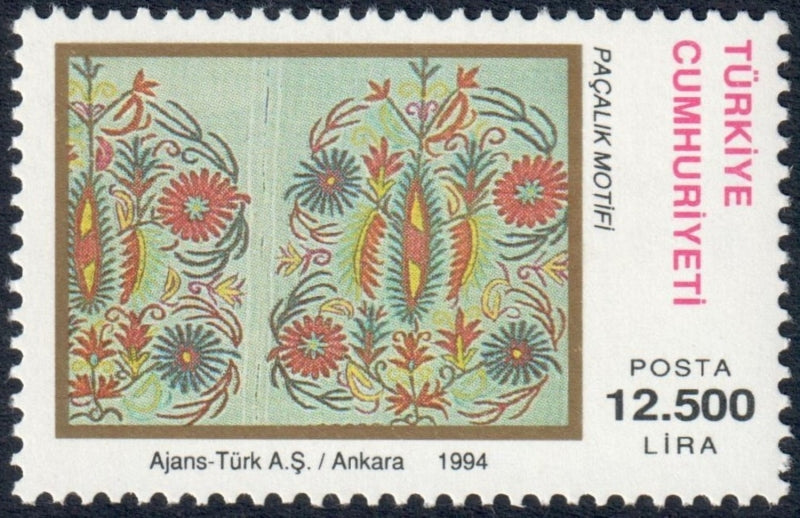
POSTAGE STAMPS: UNEXPECTED SOURCES

Image: Turkish postage stamp with embroidery, 1994. Courtesy Textile Research Centre, Leiden, acc. no. TRC 2016.0290a.
What can postage stamps tell us about the textiles of a nation? This is the question that Gillian Vogelsang-Eastwood asked recently on the Textile Research Centre Leiden regular blog. Read on for the full blog, or visit the TRC Leiden website here.
We are tidying up at the TRC Leiden in anticipation of various large donations that will shortly be coming to Leiden. As a result we came across some first-day covers and postage stamps in the collection, all with a textile theme, and this led to another look at these small, but sometimes very interesting objects. We already discussed the subject of stamps and textiles in an entry for TRC Needles, but we acquired new items since writing and, let's face it, there is nothing wrong with reminding people of yet another aspect of textile studies.
 Image: Sheet of six stamps depicting types of lace and tools (Spain, 1989). The lace dates from the XVth-XVIIIth century and come from the regions of Catalonia, Estremadura, Castilla la Mancha, Andalusia, Canary Islands and Galicia (TRC 2016.0284).
Image: Sheet of six stamps depicting types of lace and tools (Spain, 1989). The lace dates from the XVth-XVIIIth century and come from the regions of Catalonia, Estremadura, Castilla la Mancha, Andalusia, Canary Islands and Galicia (TRC 2016.0284).
One of the (younger) TRC volunteers asked about postage stamps. She apparently had never used them. She was so accustomed to emails, WhatsApp, Instagram, as well as printed-off labels, not to mention downloadable codes, that she was not exactly sure how postage stamps worked, let alone their history and the diversity of images used on them. How the world has changed in the last twenty or so years!
Looking at postage stamps as a child, for example, helped me understand where to find various countries on the map, and they developed an interest in other cultures. And equally important nowadays, they are a very useful source of information about textiles and clothing.

Image: Swiss postage stamp, 2000, machine-made embroidery. Courtesy Textile Research Centre, Leiden, acc. no. TRC 2016.0281.
So a few years ago the TRC decided to deliberately make a collection of postage stamps. We now have nearly 300 items in the stamp collection, which come from many parts of the world. These stamps illustrate different aspects of textile production, literally from fibres, spinning, weaving, to embroidered and printed textiles, as well as, for instance, the production of bobbin lace and the many other forms of lace.
In addition, there are many examples of clothing from different groups and cultures, as well as a series of paintings that provide details about clothing. In addition, we also have sheets of stamps, first-day covers, special postcards, as well as relevant stamps on everyday envelopes.
 Image: Postage stamps with folk embroidery, Ukraine, 1992. Courtesy Textile Research Centre, Leiden, acc. no. TRC 2016.0289.
Image: Postage stamps with folk embroidery, Ukraine, 1992. Courtesy Textile Research Centre, Leiden, acc. no. TRC 2016.0289.
Fascinating is a group of stamps from Iceland , with representations of Icelandic embroidery (2008), a set of Ukrainian stamps with local textiles, stamps with Kazakhstan objects , and a lovely stamp from Turkey (1994) showing the embroidery for a Pacalik dress.
We also have a group of special stamps that were made of actual textiles, such as those made from pieces of machine made lace. Some stamps are made from real materials, such as that for Lederhosen or miniature Dirndl dresses made from cloth. Other stamps are made from machine embroidered cloth in the form of, for example, crowns.
 Image: Postage stamp in the form of a dirndl outfit for a woman. The stamp has been machine embroidered. Austria 2016 (TRC 2018.2212).
Image: Postage stamp in the form of a dirndl outfit for a woman. The stamp has been machine embroidered. Austria 2016 (TRC 2018.2212).
So far, we have used these stamps and related items in various exhibitions at the TRC, such as Textile Tales from the Second World War (September 2020), and in the various embroidery encyclopaedias written and edited by the TRC (published by Bloomsbury, 2016ff.).
We have also been wondering about the possibility of making an online exhibition on the same theme, as these small, but colourful items are a useful support material for looking at the history of textiles and dress. Other plans are being developed!
Written by Dr Gillian Vogelsang, Textile Research Centre, Leiden.
--
Still looking for Christmas presents? It's not too late to order from the Selvedge online store.
But hurry, Tuesday 21st December is our last posting date for first class standard delivery in the UK!

